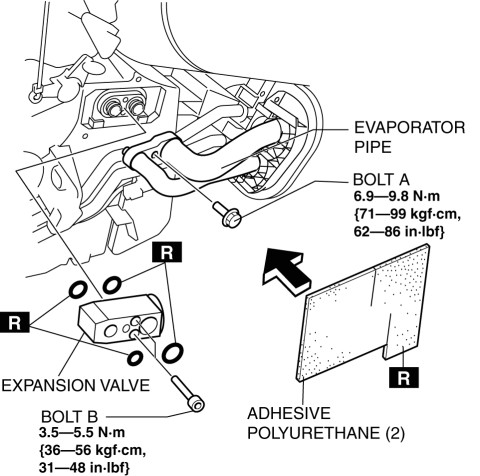Mazda 3 Service Manual: Expansion Valve Removal/Installation
1. Disconnect the negative battery cable..
2. Discharge the refrigerant from the system..
CAUTION:
-
If moisture or foreign material enters the refrigeration cycle, cooling ability will be lowered and abnormal noise will occur. Always immediately plug all open fittings after removing any refrigeration cycle parts to keep moisture or foreign material out of the cycle.
3. Disconnect the cooler hose (LO) and cooler pipe. Do not allow compressor oil to spill..
4. Remove the following parts:
a. Front side trim (RH).
b. Front scuff plate.
c. Dashboard under cover.
d. Glove compartment.
e. Lower panel (passenger-side).
f. Side wall (RH).
g. Shower duct (RH).
5. Remove the adhesive polyurethane (2)..
6. Remove the bolt A.
7. Disconnect the evaporator pipe.
8. Remove the bolt B.
9. Remove the expansion valve. Do not allow compressor oil to spill.

10. Install in the reverse order of removal.
11. Perform the refrigerant system performance test..
 Evaporator Inspection
Evaporator Inspection
1. Inspect the evaporator for damage, cracks, and oil leakage.
If there is any malfunction, replace the evaporator.
2. Visually inspect the fins for bending.
If there is any bend ...
 Fan Switch Inspection [Manual Air Conditioner]
Fan Switch Inspection [Manual Air Conditioner]
1. Disconnect the negative battery cable..
2. Remove the following parts:
a. Upper panel.
b. Shift lever knob (MTX).
c. Selector lever knob (ATX).
d. Shift panel.
e. Side wall.
f. Consol ...
Other materials:
Headlight Leveling Actuator Inspection
NOTE:
Headlight leveling actuator are integrated with the front combination light.
For the actuator inspection of the headlight auto leveling system, perform
the headlight leveling actuator operation inspection..
1. Measure the voltage at each terminal is as indicated in the ...
Ignition Switch
Push Button Start Positions
The system operates only when the key is
within operational range.
Each time the push button start is pressed,
the ignition switches in the order of off,
ACC, and ON. Pressing the push button
start again from ON switches the ignition
off.
NOTE
The engine ...
Supplemental Restraint System (SRS) Precautions
The front and side supplemental restraint systems (SRS) include different
types of air bags.
Please verify which kinds of air bags are equipped on your vehicle by locating
the
“SRS AIRBAG” location indicators. These indicators are visible in the area where
the air
bags are installed.
T ...
